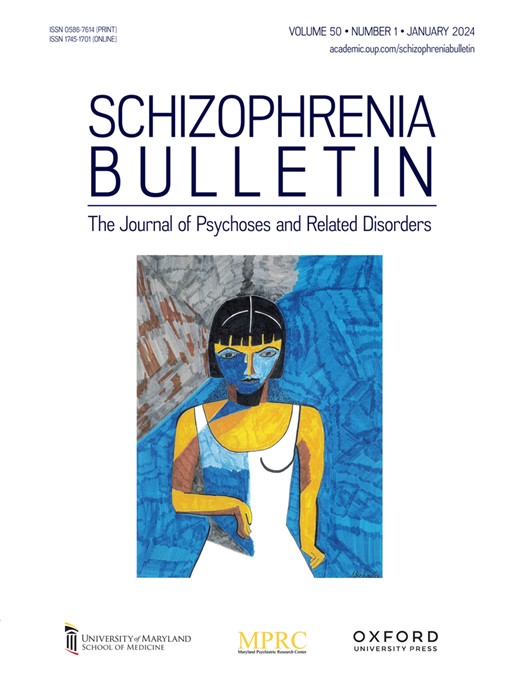内侧前额叶皮层g - α13过表达通过Adcyap1/cAMP/PKA/NMDAR通路扰乱社会行为
IF 4.8
1区 医学
Q1 PSYCHIATRY
引用次数: 0
摘要
社交退缩是精神分裂症的核心症状,但其潜在的分子机制尚不清楚。Gα13 (GNA13)是G蛋白α亚基,与SCZ易感性有关。本研究通过在小鼠内侧前额叶皮层(mPFC)锥体神经元中过表达g - α13来研究其在社会行为中的作用。本研究首先利用CRISPR/Cas9技术构建过表达Gα13基因的CRE重组酶小鼠,通过三盒社会化实验检测小鼠的社交行为,通过钙信号光纤记录检测小鼠社交活动中神经元活动的变化,通过高尔基染色观察树状棘的变化,应用RNA测序(RNA- seq)寻找相关靶点。并通过药理实验观察其能否逆转社会行为的异常。采用全细胞膜钳技术检测Gα13过表达的电生理特征,采用PANSS量表评估SCZ患者的严重程度和社交戒断行为,ELISA技术检测人血浆Gα13蛋白水平,并评估两者的临床相关性。结果Gα13过表达(Gα13- oe)小鼠在三室实验中表现出明显的社交缺陷,社交能力下降,但社交新颖性识别正常。纤维光度记录显示,社交互动时神经元活动减少,高尔基染色显示mPFC锥体神经元的树突棘密度减少。RNA-Seq鉴定Adcyap1下调,影响cAMP/PKA信号通路和NMDA受体(NMDAR)功能。用PACAP-38或d -环丝氨酸激活Adcyap1或NMDAR可挽救社交缺陷并恢复突触功能。相反,在mk -801诱导的SCZ小鼠模型中,g - α13的敲低可改善社会行为异常。临床中,SCZ患者血浆中Gα13水平升高,与PANSS G16项目测量的社交戒断症状严重程度呈正相关。结论Gα13在mPFC中的过表达通过Adcyap1/cAMP/PKA/NMDAR通路破坏神经元功能和突触可塑性,从而影响社交行为。靶向Gα13可能为解决SCZ社会缺陷提供一种新的治疗策略。本文章由计算机程序翻译,如有差异,请以英文原文为准。
Gα13 Overexpression in the Medial Prefrontal Cortex Disrupts Social Behavior Through the Adcyap1/cAMP/PKA/NMDAR Pathway
Background Social withdrawal is a core symptom of schizophrenia (SCZ), yet its underlying molecular mechanisms remain unclear. Gα13 (GNA13), a G protein alpha subunit, has been implicated in SCZ susceptibility. This study investigated the role of Gα13 in social behavior by overexpressing it in the medial prefrontal cortex (mPFC) pyramidal neurons of mice. Study Design In this study, we first constructed CRE recombinase overexpressing Gα13 gene mice using CRISPR/Cas9 technology, tested the social behaviors by three-box socialization test, detected the changes of neuronal activities during social activities in mice by calcium signal fiber-optic recordings, observed the changes of dendritic spines by Golgi staining, applied RNA sequencing (RNA-Seq) to find the relevant targets, and observed whether it could reverse the abnormalities by pharmacological experiments social behavior. The electrophysiological characteristics of Gα13 overexpression were investigated using the whole-cell membrane clamp technique, followed by assessment of the severity of SCZ patients and social withdrawal using the PANSS scale and measurement of human plasma Gα13 protein levels using the ELISA technique, and the clinical correlation between the two was assessed. Study Results Gα13 overexpression (Gα13-OE) mice exhibited significant social deficits in the three-chamber test, showing reduced sociability but normal social novelty recognition. Fiber photometry recordings revealed decreased neuronal activity during social interactions, and Golgi staining showed reduced dendritic spine density in mPFC pyramidal neurons. RNA-Seq identified downregulation of Adcyap1, affecting the cAMP/PKA signaling pathway and NMDA receptor (NMDAR) function. Pharmacological activation of Adcyap1 with PACAP-38 or NMDAR with D-cycloserine rescued the social deficits and restored synaptic function. Conversely, knockdown of Gα13 in an MK-801-induced SCZ mouse model ameliorated social behavior abnormalities. Clinically, patients with SCZ exhibited elevated plasma levels of Gα13, which positively correlated with the severity of social withdrawal symptoms measured by the PANSS G16 item. Conclusions These findings suggest that overexpression of Gα13 in the mPFC impairs social behavior by disrupting neuronal function and synaptic plasticity via the Adcyap1/cAMP/PKA/NMDAR pathway. Targeting Gα13 may offer a novel therapeutic strategy for addressing social deficits in SCZ.
求助全文
通过发布文献求助,成功后即可免费获取论文全文。
去求助
来源期刊

Schizophrenia Bulletin
医学-精神病学
CiteScore
11.40
自引率
6.10%
发文量
163
审稿时长
4-8 weeks
期刊介绍:
Schizophrenia Bulletin seeks to review recent developments and empirically based hypotheses regarding the etiology and treatment of schizophrenia. We view the field as broad and deep, and will publish new knowledge ranging from the molecular basis to social and cultural factors. We will give new emphasis to translational reports which simultaneously highlight basic neurobiological mechanisms and clinical manifestations. Some of the Bulletin content is invited as special features or manuscripts organized as a theme by special guest editors. Most pages of the Bulletin are devoted to unsolicited manuscripts of high quality that report original data or where we can provide a special venue for a major study or workshop report. Supplement issues are sometimes provided for manuscripts reporting from a recent conference.
 求助内容:
求助内容: 应助结果提醒方式:
应助结果提醒方式:


